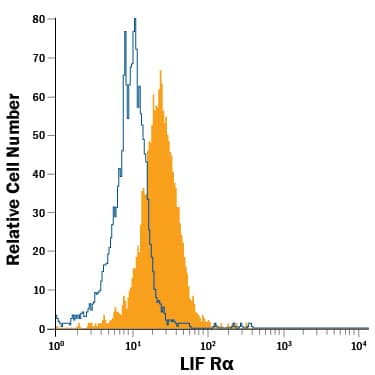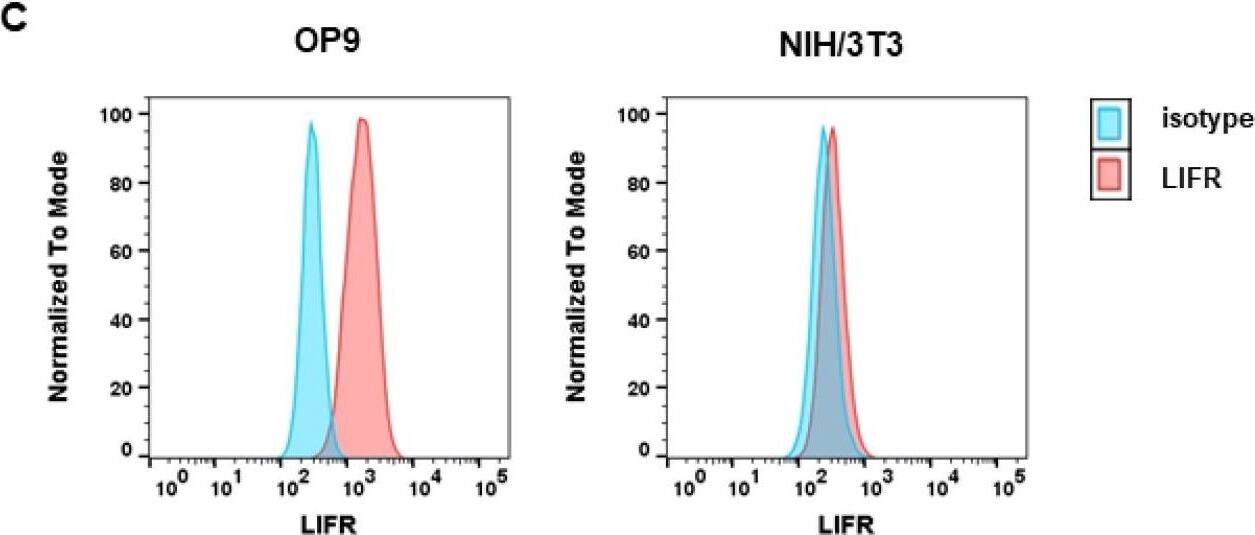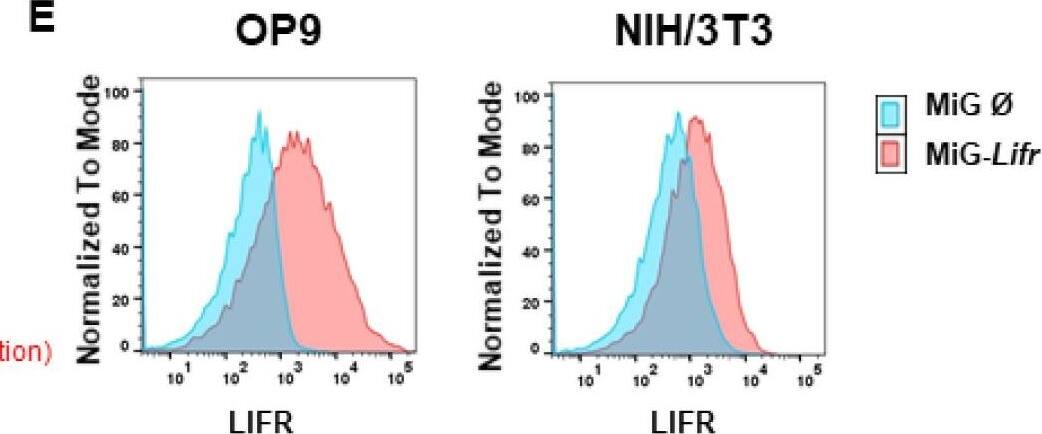Mouse LIFR alpha PE-conjugated Antibody
R&D Systems, part of Bio-Techne | Catalog # FAB5990P


Conjugate
Catalog #
Key Product Details
Species Reactivity
Validated:
Mouse
Cited:
Transgenic Mouse
Applications
Validated:
Flow Cytometry
Cited:
Flow Cytometry
Label
Phycoerythrin (Excitation = 488 nm, Emission = 565-605 nm)
Antibody Source
Monoclonal Rat IgG1 Clone # 673602
Product Specifications
Immunogen
Mouse myeloma cell line NS0-derived recombinant mouse LIF R alpha
Leu44-Ser828
Accession # P42703
Leu44-Ser828
Accession # P42703
Specificity
Detects mouse LIF R alpha in direct ELISAs.
In direct ELISAs, no cross-reactivity
with recombinant human LIF R alpha is observed.
Clonality
Monoclonal
Host
Rat
Isotype
IgG1
Scientific Data Images for Mouse LIFR alpha PE-conjugated Antibody
Detection of LIF R alpha in D3 Mouse Cell Line by Flow Cytometry.
D3 mouse embryonic stem cell line was stained with Rat Anti-Mouse LIF Ra PE-conjugated Monoclonal Antibody (Catalog # FAB5990P, filled histogram) or isotype control antibody (Catalog # IC005P, open histogram). View our protocol for Staining Membrane-associated Proteins.Detection of Mouse LIFR alpha by Flow Cytometry
OP9 and NIH/3T3 cells show differential levels of OSMR and LIFR. (A) OP9 and NIH/3T3 cells were examined for LIFR and OSMR expression. BaF3 cells were used as a negative control. Protein molecular weight is labeled in kDa. Relative protein quantities are marked in red. (B) Microarray analysis of OP9 and NIH/3T3 cells showing Osmr and Lifr expression. The p-values were calculated by Transcriptome Analysis Console software. *** p < 0.001. ns = not significant. (C) OP9 and NIH/3T3 cells were analyzed for LIFR surface expression using FACS. (D) OP9 and NIH/3T3 cells were examined for expression of LIFR and OSMR in relation to different incubation periods with 10 ng/mL mOSM. Protein molecular weight is labeled in kDa. (E) OP9 and NIH/3T3 cells were examined for LIFR surface expression in relation to different incubation periods with 10 ng/mL mOSM. p-Values were calculated using one-way ANOVA and Bonferroni post-test. * p <0.05 and *** p < 0.001. ns = not significant. Image collected and cropped by CiteAb from the following open publication (https://pubmed.ncbi.nlm.nih.gov/34769079), licensed under a CC-BY license. Not internally tested by R&D Systems.Detection of Mouse LIFR alpha by Flow Cytometry
OSMR downregulation attenuates OSM effects on proliferation. (A,B) Immunoblot quantifying the shRNA-induced knockdown of Osmr (n = 4) and Lifr (n = 5) in (A) OP9 and (B) NIH/3T3 cells. The shRNAs Osmr 5 and Lifr 1 were used in subsequent experiments. Protein molecular weight is labeled in kDa. Relative protein quantities are indicated in red. (C) Relative quantification of S phase of OP9 and NIH/3T3 cells carrying a knockdown for either Osmr, Lifr, or a Renilla control in presence or absence of 10 ng/mL mOSM. Cell cycle analysis was performed as described before. One-way ANOVA and Bonferroni post-test. *** p < 0.001. ns = not significant. (D) Immunoblot quantifying the LIFR overexpression in OP9 and NIH/3T3 cells. Protein molecular weight is labeled in kDa. Relative protein quantities are indicated in red. (E) Lifr overexpressing OP9 and NIH/3T3 cells were examined for LIFR surface expression compared to cells carrying the mock control. (F) Relative quantification of S phase of OP9 and NIH/3T3 cells transduced with Lifr or empty vector (MiG). Cell cycle analysis was performed as described before. One-way ANOVA and Bonferroni post-test. * p < 0.05, ** p < 0.01, and *** p < 0.001. Image collected and cropped by CiteAb from the following open publication (https://pubmed.ncbi.nlm.nih.gov/34769079), licensed under a CC-BY license. Not internally tested by R&D Systems.Applications for Mouse LIFR alpha PE-conjugated Antibody
Application
Recommended Usage
Flow Cytometry
10 µL/106 cells
Sample: D3 mouse embryonic stem cell line
Sample: D3 mouse embryonic stem cell line
Reviewed Applications
Read 1 review rated 5 using FAB5990P in the following applications:
Formulation, Preparation, and Storage
Purification
Protein A or G purified from hybridoma culture supernatant
Formulation
Supplied in a saline solution containing BSA and Sodium Azide.
Shipping
The product is shipped with polar packs. Upon receipt, store it immediately at the temperature recommended below.
Stability & Storage
Store the unopened product at 2 - 8° C. Do not use past expiration date. Protect from light.
Background: LIFR alpha
Long Name
Leukemia Inhibitory Factor Receptor alpha
Alternate Names
CD118, LIF R alpha, LIF R beta, LIFR, LIFRa
Gene Symbol
LIFR
UniProt
Additional LIFR alpha Products
Product Documents for Mouse LIFR alpha PE-conjugated Antibody
Product Specific Notices for Mouse LIFR alpha PE-conjugated Antibody
For research use only
